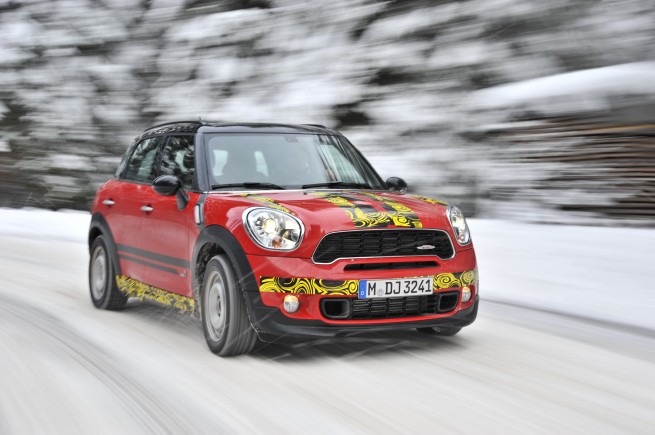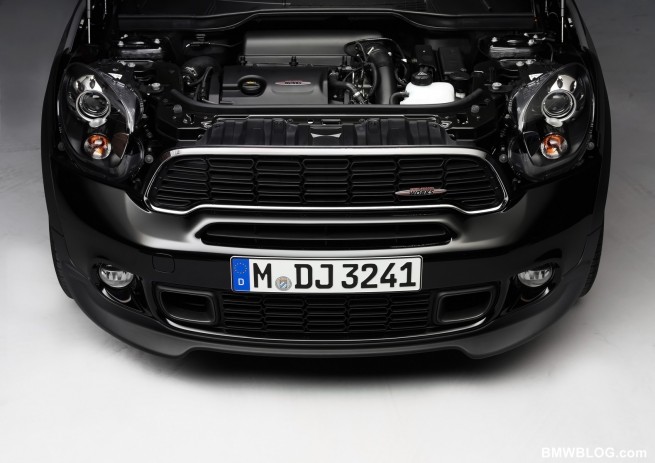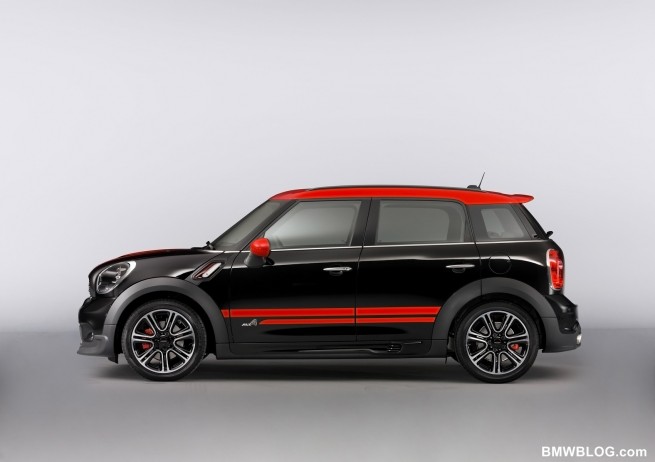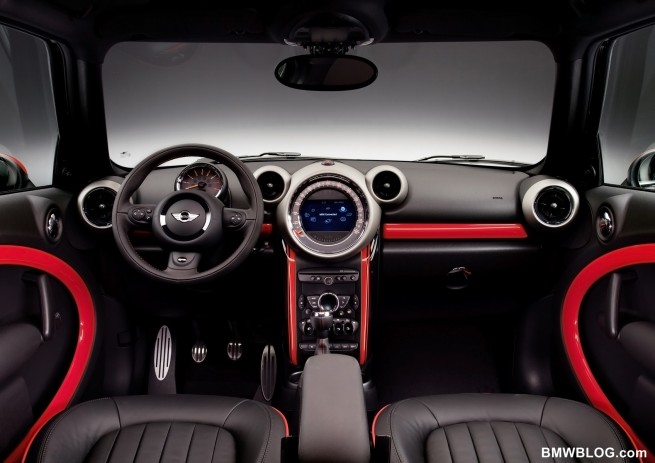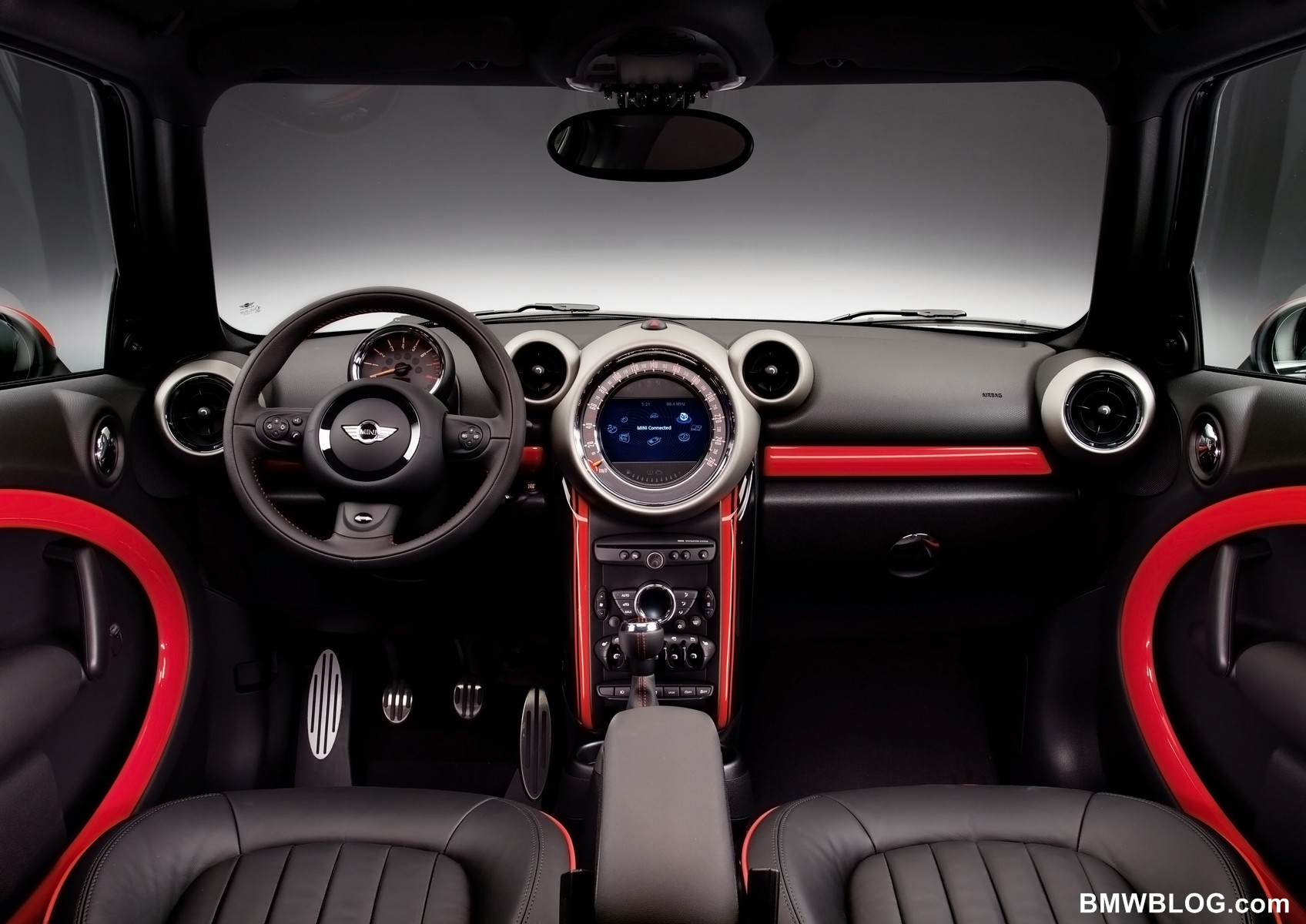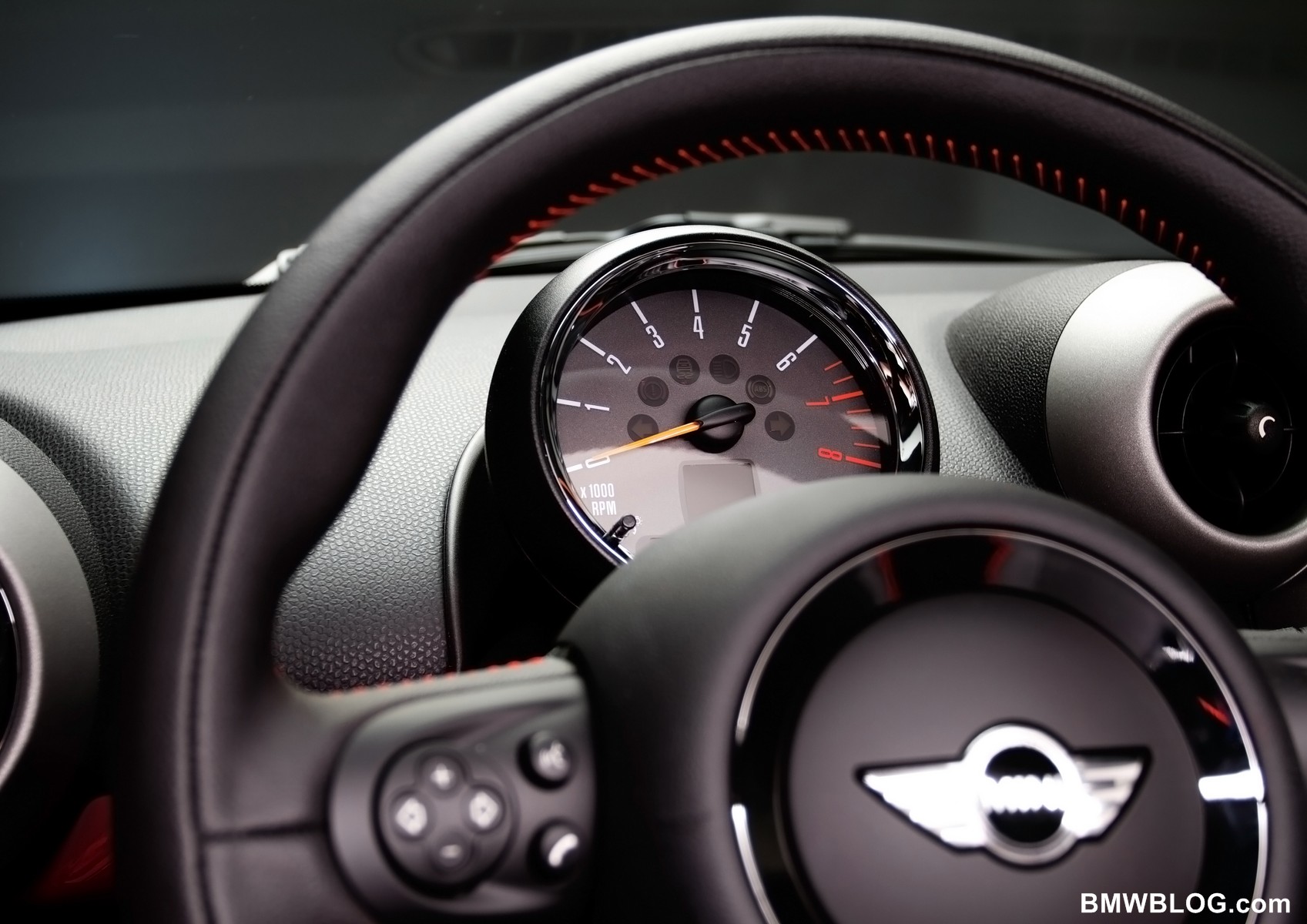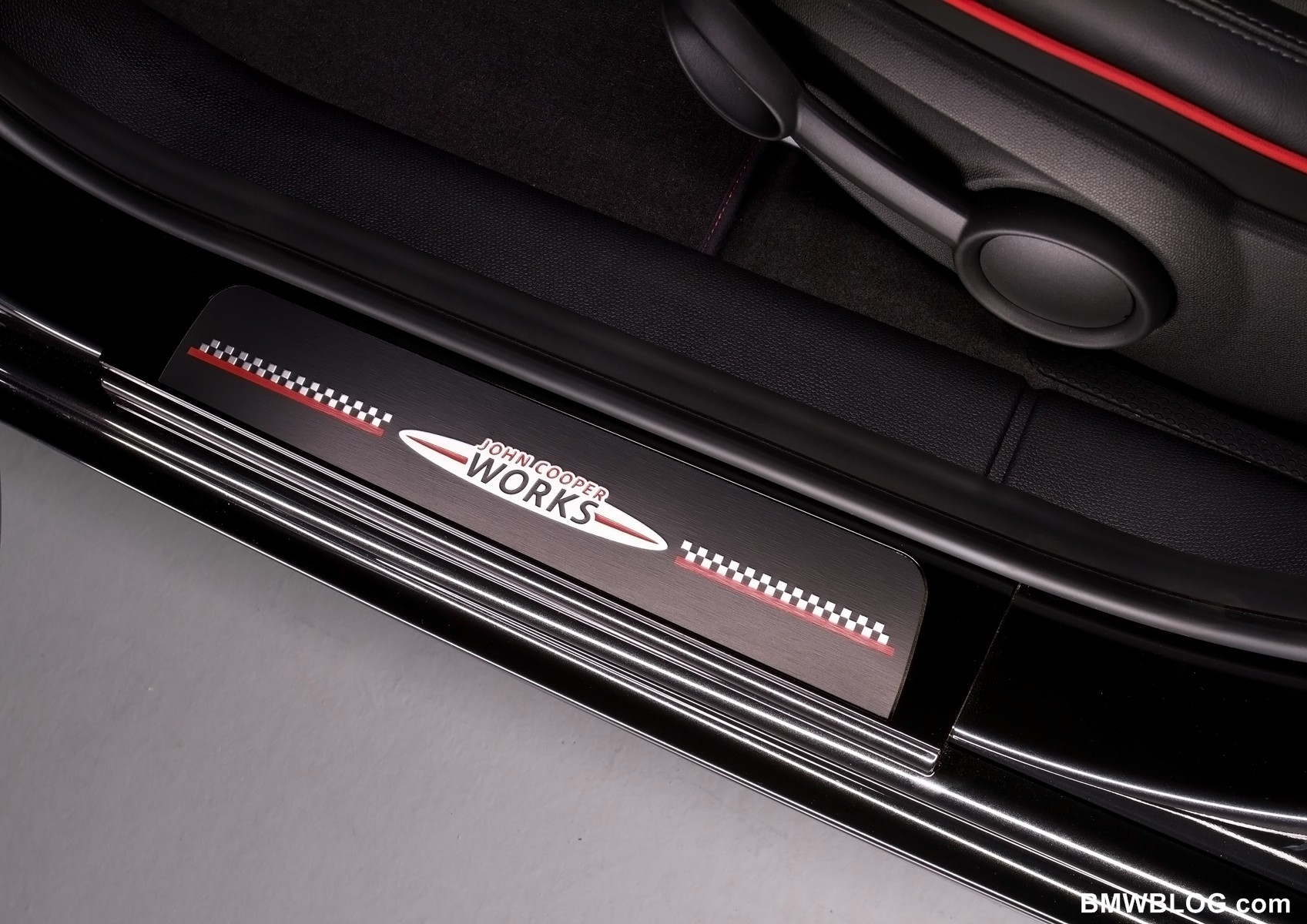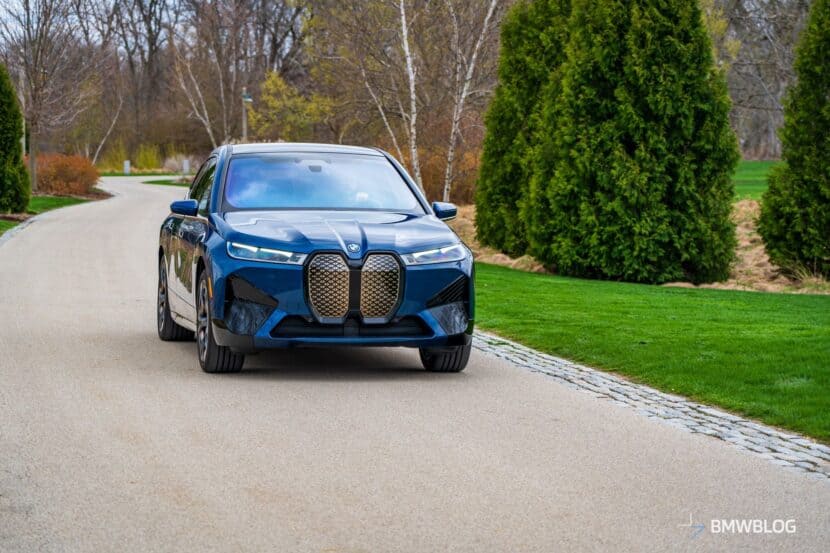When MINI released the Countryman in early 2010, some fans of the brand called foul. MINI producing a larger four-door seemed almost sacrilegious – it was the unthinkable – like Ferrari producing an all-wheel drive sports car (Achhem: the Ferrari FF). Apparently rules are meant to be broken. In the process of rule breaking, not only are sterotypes defeated, but sometimes great new products surface.
I was among the first to drive MINI’s spicy new version of the Countryman – in fact, it was still in prototype form with swirly stickers over parts of the body work, but the mechanical details were near sign-off. While we were already content with the dynamics of the Countryman S model, the JCW takes back-road blasts to a whole new level. We expect the Countryman JCW edition to go on sale in the North American market in the second half of this year.
Starting with the Countryman S as a baseline, the JCW version adds several technical modifications, starting with the suspension. The new JCW version sports a suspension lowered by 10 mm, with slightly stiffer spring rates and stiffer anti-roll bars, now measuring 22 mm and 17 mm front and rear. The standard wheel size will measure 17 inches, with larger wheels available as an option. The rear brakes have also grown by 16 mm to 296 mm (16″), which should reduce understeer while braking into a corner.
The suspension is burdened with a 1,460 kg (3,220 lb) curb weight, a far cry from the original MINI’s 616 kg (1,360 lb), however the Countryman JCW serves up curvy-road moves that would suggest it carries less weight than the scales confirm. The Countryman JCW may weigh twice as much as its ancestral forefather, but it’s also more than twice its size, and at least 10 times more practical.
The same 6 speed manual as found in the Countryman S model will be the stand-alone transmission featured in the JCW – the 6 speed manual being the weapon of choice for those who enjoy an engaging drive. The three pedal option was a joy to drive with precise engagement and short throws of the stick. Pedal placement was a bit tricky for heel-and-toe downshifting with the brake and gas pedals just a tick too far apart. A wider floor-hinged accelerator pedal would improve the situation, and considering the driving habits of JCW cliental, this detail is more significant than in cars with a less sporting pedigree. The clutch pedal was a touch light for a hardened sports car, but MINI was quick to emphasize that the Countryman JCW aims to please its owner as a well-rounded daily driver. Porsche 911 levels of clutch resistance would likely deter many potential buyers from signing on the dotted line, so a compromise was found somewhere down the middle.
On to the engine department, the brilliant 1.6 liter single twin-scroll turbo 4-cylinder found in the ‘S’ model has been massaged with Valvetronic variable valve lift found standard, along with direct injection. MINI has taken things a step further by remapping the ECU and tweaking the mechanicals to produce a substantial boost in power. The current 1.6 liter JCW engine as found in the Cooper JCW produces 208 hp, and the Countryman JCW’s output jumps to 211 hp. This is a staggering figure for a 1.6 liter, offering up a specific output of 132 hp / liter. Torque has remained the same from the previous engine’s 207 lb-ft, producing 221 lb-ft between 2,100 and 5,200 rpm with over-boost. The exhaust note is surprisingly audible and baritone for a small displacement turbo 4-cylinder. We loved the growl this car let loose as it reminded us that we were in a performance car without being too loud or obnoxious.
Transferring all of this power to the wheels is MINI’s standard issue “ALL4” all-wheel-drive system. ALL4 is based on MINI’s front-wheel drive drivetrain, but adds an electronically modulated power-take-off differential sending twist to the rear wheels. Typical driving will see power sent exclusively to the front wheels, though during spirited blasts you could see as much as 100% of the power routed to the front wheels, or 60% routed to the rear wheels – giving the car a surprisingly rear-wheel drive feel while accelerating out of corners. At 120 km/h the transfer case begins to tapper off the amount of power sent to the rear wheels, until the wet multi-plate clutch-pack is completely opened at 140 km/h, rendering the car front-wheel-drive only above this speed for reasons of fuel conservation.
So how does it drive? Carving along snow and ice-covered Alpine passes in the heart of Austria, the Countryman JCW clawed like a scared cat. Steering feel and feedback is excellent and not dumbed down by the electric power steering assist (replacing the hydraulic steering assist of yore). The electric assist motor is mounted directly to the rack and can be dialed down by pressing the “Sport” button on the main console. In sport mode electric assist is lessened by approximately 30% according to MINI engineers, thus offering up raw information through the steering wheel – just the way we like it. Now if only BMW could replicate the feeling and feedback of this EPS across the entire BMW line. Sport mode also increases throttle pedal sensitivity, creating a more eager drive experience.
The boosted engine power, stiffer suspension settings, and all-wheel-drive system converge to provide a scintillating experience behind the wheel while prodding the car’s limits. Setting off on a snowy road the Countryman JCW quickly found a fast clip and seemed to beg for more throttle. Whereas all previous MINI JCW products featured front-wheel-drive, the Countryman JCW trumps all of them with its ability to put the power down through all four wheels – nearly free of torque steer or understeer. With the dynamic stability control system (DSC) partially defeated, the Countryman JCW will happily power slide through corners at conservative slip angles of approximately 10 to 20 degrees before “catching” the car and bringing it back in line. Turn the DSC completely off and you will have your own version of MINI’s factory World Rally Championship race car, with hair-raising power slides a real possibility. We drove MINI’s new Coupe JCW back to back with the Countryman JCW, and for its more neutral handling, we would choose the Countryman as the ultimate JCW performance MINI – particularly if unfavorable road conditions are in the equation.
Efficiency is excellent in typical MINI fashion with average fuel consumption of 7.2 liters per 100 kilometers / 39.2 mpg imp in the EU test cycle. US EPA figures are yet to be announced. These figures are particularly impressive when compared against the Countryman JCW’s competition from other marquees, particularly the always thirsty Subaru WRX STI.
The cost of admission is yet to be disclosed for the US and Canadian markets. Based on current MINI pricing, we would expect the Countryman JCW to land somewhere between the high $30,000 and low $40,000 mark. This may sound like a steep price tag, but our seat-of-the-pants-o-meter tells us that it might be money well spent if you have a hankering for performance in a practical four-door hatchback.
The MINI JCW Countryman made its first public appearance at the Geneva motor show.
Special thanks to Irvine MINI for their sponsorship of this car review. Irvine MINI is one of the premier dealerships in Orange County, Los Angeles, and the entire country. To book your appointment with their relaxed sales team, click here. Hit the jump to leave a smile on their Facebook page.



